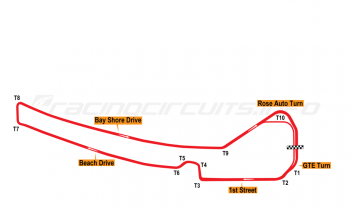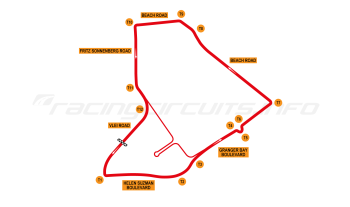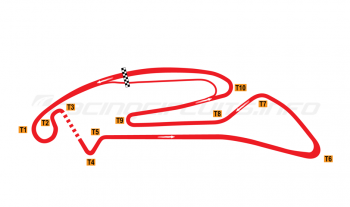Sandown Raceway
Circuit Overview
Sandown Raceway promotes itself as 'the home of horsepower' and with good reason; it is now one of Australia's oldest permanent motor racing facilities and also houses a busy horse racing circuit within its perimeter.
Nestling within Melbourne's Springvale suburbs, the circuit today hosts five major meetings each year, the highlight of which is the annual visit of Australian Supercar Championships.
While it's long term future may still be undetermined and despite various 'replacement' venues being mooted, Sandown manages to soldier on and remains a hugely popular facility with drivers.
Circuit History
The site itself has long been earmarked for leisure use. An early horse racing course was established in 1888 as Oakleigh Park, changing its name to Sandown Park in 1892. Horse racing was extremely popular at this point, and the course was one of a number of private facilities to spring up around the growing city. It was at this facility that the first car race in Australia took place in March 1904. Sandown Park's original equine course ran until 1931 at which point it closed in a government rationalisation program and the land was largely abandoned.
First raceway is born
By the early 1960's, the Victorian Amateur Turf Club merged with both the Victorian Turf Racing Association and Williamstown Turf Club, which enabled them to raise the capital to purchase and develop the Sandown facility for use once more. Perhaps inspired by the Aintree course in England and Australia's own Warwick Park, their plans called for a dual-use facility, bringing motor racing for the first time on a permanent course and restoring horse racing on a new turf course.
Aussie racing legend Len Lukey was one of the key figures in the development of the motor racing facility, alongside Neil Marsden, the former secretary of the Light Car Club of Australia (LCCA). Sandown Park Motor Sport Pty Ltd was formed to handle promotion of racing events, with Marsden as the managing director.
Construction began in 1961 and the motor racing circuit was completed by the following year, with the horse racing track following in 1965. The roar of racing engines at the new Sandown thus came ahead of the galloping of horses, with a star-studded inaugural meeting in March 1962. The race attracted names such as double world champion Jack Brabham, Jim Clark, Rob Flockhart, Chuck Daigh and New Zealand champion Pat Hoare.
The Sandown International Cup, as it became known, continued to attract the star turns of the day through the 1960s, as it formed a key part of the Tasman Series. Winners of races here read like a who's who of contemporary racing; Brabham, Stewart, Clark and Amon all claimed trophies and the event was bestowed the prestigious Australian GP title in 1954, 1968, 1972-3, 1976 and 1978.
Despite these headline attractions, attendances at other events were not sufficient to sustain a profit and the lease was taken on by the LCCA itself in 1966. The steady demise of the Tasman Series and its replacement Gold Star category saw the popularity of the single seater events wane considerably and it was soon the touring car categories which took on greater importance. Six hour races for production cars were held in 1965 and 1966 before switching first to a 250km then a 400km endurance format, with the race assuming its now traditional role as the warm-up event to the Bathurst 1000.
Into the Group C era, the Holden vs Ford rivalry took hold, with every event won by one of the two manufacturers until 1982. Peter Brock dominated between 1973-84, with only Allan Moffat able to interrupt his winning streak, claiming a Ford win in 1974 and the victory laurels for Mazda in 1982 and 1983.
Facilities for competitors at this stage were somewhat basic. The pit lane was cramped and the paddock an often muddy area of hard-standing – hardly likely to attract international events. Safety was also questionable in the modern era, the fast esses at the back of the circuit and the final corner with its causeway crossing and unprotected bridge abutment causing particular concern.
International expansion
The LCCA had its eye on bringing back top-line racing to Sandown and set about ambitious expansion plans. Securing government funding to upgrade the track to Formula 1 standards, it hoped to be awarded a round of the Formula 1 World Championship. The first visible change was the removal of the Dunlop Bridge in early 1984 and, following the round of the Australian Touring Car Championship, work commenced to create a new infield loop (crossing the horse track for the first time) and revised first and final corner sequences. The pit lane was also moved to the beginning of the start/finish straight, with some $600,000 spent on modern pit and paddock facilities.
In the end, politics played their part in Sandown's failure to attract a Grand Prix. The Victorian State Government refused to support the bid and Adelaide instead secured the race for South Australia. In its place, the LCCA secured another world event, the final round of the 1984 World Endurance Championship for sportscars, making it the first FIA World Championship road racing motor racing event to be held in Australia.
The Sandown 1000km event was to prove something of a flop; Lancia elected not to attend as the round did not count for the Manufacturer's Championship, while the track surface began to break up under the power of the mighty Group C sportscars. Drivers were left unimpressed with the new infield layout, finding its tight and twisty, while spectators bemoaned the loss of the fast esses, which had been a popular viewing area in the 1960s and '70s. The race was flagged 50 laps early having run up against its six hour time limit, the works Porsche of Stefan Bellof and Derek Bell taking the win.
Spectator turnout was low – officially recorded as 13,860 – and with no event sponsor, the event was a financial bloodbath. Some estimates put the LCCA's losses at anything up to $500,000 and as a result the final two years of the contract were cancelled. Perhaps somewhat surprisingly, the LCCA elected to try its hand again in 1988, this time bringing the sportscars back for a 360km sprint event, the final round of the World Sports Prototype Championship. The Sauber-Mercedes of Jochen Mass and Jean-Louis Schlesser took the win ahead of its sister car driven by Mauro Baldi and Stefan Johansson.
The race would prove to be the final top level motor race on the 3.9 km International Circuit, with Schlesser setting the circuits outright lap record with a time of 1:33.580. From 1989 the extended course was effectively mothballed for cars, though motorcycles would continue to use it into the the early 2000s, preferring to avoid the fast esses section on safety grounds.
With the losses having piled up for the LCCA after a second unsuccessful sportscar event event promotion at Sandown passed in 1990 to former racer Jon Davison. The LCCA itself was declared bankrupt two years later. The focus would remain on the domestic racing scene, while the Melbourne Racing Club (owners of the overall facility) pursued upgrades to spectator facilities and the horse racing course. In 2002, the creation of an extended turf course spent the end of the international loop altogether, although a few forlorn sections of bitumen still exist as a reminder of past follies.
In-house management
In 2007, the Melbourne Racing Club brought the operation of the motor racing circuit in house. To secure the Raceway's future, the club negotiated a long term deal with V8 Supercars, keeping the venue on the calendar until at least 2020. Part of this deal included significant investment in upgraded pit and paddock facilities, plus a three-year plan to upgrade safety. This has seen a general widening and deepening of tyre barriers, a resurfacing of around 1/6th of the track, removal of old earth tyre barriers and improvements to run-off areas at key parts of the course.
A new three-year deal extending the Supercars events until 2023 was signed in 2019 (albeit with the race now a regular sprint round, rather than an endurance event). The new contract followed significant further safety upgrades being completed in two phases over 2018 and 2019. The first phase was a temporary solution to replace a section of Armco (multi-layer steel barrier) on the outside of the infamous Turn 6, while deteriorated and old tyre stacks have been changed. In their place 29 four-metre long concrete blocks weighing four tonnes each were borrowed from the Australian Grand Prix to install behind renewed tyre barriers. The new tyre bundles, contained by rubber belting, were fitted with energy-absorbing inserts, which again come courtesy of the AGP.
The track surface was also extended on the outside of Turn 1, to give more leeway before going into the run-off area for wayward drivers at the end of the main straight.
A more permanent solution was planned for Turn 6 in 2019, with the second phase designed in conjunction with track design specialists iEDM and its consultant Mark Skaife, in order to re-secure the FIA Grade 3 rating necessary to host supercars. The track closed completely for five weeks from the end of July to allow the works to be undertaken. Major earthworks saw the bank at the outside of corner moved back 18 metres to provide significant extra run-off. A new concrete wall replaces the previous barrier, protected by a four-deep layover of tyres, wrapped in a conveyor belt. Various parts of the course were also resurfaced at the same time.
The investment in the upgrades has reflected a change of heart from the Melbourne Racing Club, which had been exploring plans to sell off the whole site for housing after 2020. These plans have been shelved for the foreseeable future, with the facility still required as a second-level horse racing venue and the motor racing circuit's driver training, track days and manufacturer events are highly profitable.
As long as the cost of upgrading the track can be contained to hundreds of thousands of dollars rather than millions, it seems likely that the MRC will now be happy to continue racing into the medium term.
Due to its close proximity to local residents, Sandown is restricted to running five major Motorsport weekends a year, at no louder than 95 decibels. Currently these include the V8 Supercars event (mid September - but switching to late November from 2020), Historic Sandown (early November), State Race Series rounds (May and July), and Shannons Nationals (September).
With thanks to Terry Walker for additional circuit information
Jump onboard
Rate This Circuit
Votes: 6878
Get your race tickets!
Brought to you with: 
We've teamed up with Motorsports Tickets to bring you the best deals for Formula One, MotoGP, Le Mans and more.












